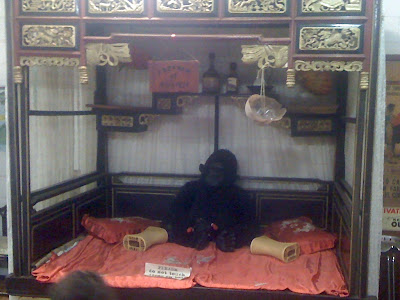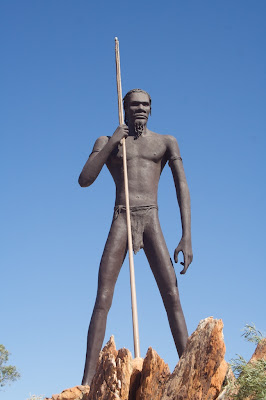


.jpg)

A panoramic photo blog around Australia



.jpg)


 Left Darwin for 3 days in Kakadu national park, stopping off at the Adelaide River for the obligatory jumping croc cruise (fun, if a frivolous waste of pork chops).
Left Darwin for 3 days in Kakadu national park, stopping off at the Adelaide River for the obligatory jumping croc cruise (fun, if a frivolous waste of pork chops).  Kakadu is spectacular, and even toward the end of the dry season there's a load of wildlife- all kinds of waterbirds (such as the magpie goose in the pic below), dingoes (heard howling in the night, cool if a little creepy)and of course crocs. The Aboriginal rock art is the best I've seen so far and the views out over the floodplains and escarpments are unforgettable. It's bloody hot though, 37 to 39 degrees the whole time, and the mosquitos are killer!
Kakadu is spectacular, and even toward the end of the dry season there's a load of wildlife- all kinds of waterbirds (such as the magpie goose in the pic below), dingoes (heard howling in the night, cool if a little creepy)and of course crocs. The Aboriginal rock art is the best I've seen so far and the views out over the floodplains and escarpments are unforgettable. It's bloody hot though, 37 to 39 degrees the whole time, and the mosquitos are killer!




In Katherine we took the obligatory cruise through the gorge, then headed up to Edith Falls and Litchfield National Park en route to Darwin.

The surroundings in the Top End are noticeably more tropical and so is the humidity (although the temperatures are still in the mid-low 30s) so the fact that pretty much every spot we visited had a swimming hole was pretty welcome!

The other thing thats immediately noticeable about the Top End is the number of World War II heritage sites. For the rest of Australia and NZ I guess the war was something that happened a long way away- it only really affected us directly in that so many of our grandfathers got turned into meat patties there. In the NT the war affected Australia directly- Darwin was bombed more than 40 times (which pretty much meant it had to be completely rebuilt, considering it was only a small backwater of a few thousand people then) and almost the entire state acted as a forward base for the allied war effort against Japan. It's fitting then that Adelaide River is the site of Australia's only war cemetary, and those Australians who lost their lives in the NT defending AUstralia are buried there.








The first 100km of the road are in pretty good condition- at times we're cruising along the flat red dirt at 100km/h, at least until an oncoming road train or other vehicle temorarily blinds us with a huge dust cloud! The terrain is flat, and the temperature is climbing- by mid-afternoon the mercury nudges 38 degrees, and for the next week it hits at least 34-35 every day. We turn off the main road to head down the side road to Winjana Gorge and Tunnel Creek, which proves to be slower going due to some heavy corrugation in places. The sight of the sheer escarpment of the Napier Range rising ubruptly out of the plain is amazing, and unlike anything I've seen aywhere else- the closest I can thin of is the karsts of Halong Bay in Vietnam, but transported onto dry land in arid savannah country.

Tunnel creek is fairly empty, with the pools of water in the underground passages less than
knee deep, but it's still an interesting spot. On the way back we visit the ruins of an old homestead and police outpost, where there are some informative information boards detaling the regions bloody earlier history- when the local Aboriginal population were forced off their traditional lands by pastoralists or rounded up to work as indentured labourers in the pearling fields around Broome. Winjana Gorge is spectacular, and a 7km return walk through the gorge early the next morning rewards us with loads of sightings of freshwater crocodiles cruising the waters of the river.

The next day we head on east, as the road crosses first the Napier and then the King Leopold ranges, the scenry becomes more spectacular and the feeling of real isolation kicks in with the realisation that we're hundreds of kms of dirt road from the nearest town. The road becomes rougher in places, with the occasional creek crossing (no obstacle at this time of year as we're deep into the dry season, but they must be a different proposition after the wet!).

We still make pretty good time, and we reach the Mt Barnett roadhouse (approximately the halfway point) by mid afternoon, after stopping at Galvan's Gorge, a beautiful spot a short walk off the road. We fill up on some seriously expensive gas ($1.95/litre!) and head down the side track to Manning Gorge, our second campsite. There's a fantastic swimming hole right next to the campground, and in the morning we discover an even better one (maybe Australia's best? let me know if you know a better one!!) a 45 minute walk away. The waterfalls are pretty much dry at this time of year but it's still beautiful- I can only think about how amazing these places must be just after (or during) the wet season.


Heading east again, we reach the Kalumburu turnoff after another 100km or so. From here the road becomes rougher and stonier, and slower going- it's now a struggle to keep much above 50km/h. The roads well formed enough, but so dry that it's corrugated badly- and the harsh, stony surface means you can't risk running too lower a tyre pressure, although I drop them to 32psi all round. Amazingly (considering that we're on a set of well-worn road tyres) we complete the entire road without a single puncture (guess I used up all the bad tyre luck in Karajini). Elenbrae Homestead provides a welcome break from the teeth-ratttling corrugations, and it;s almost bizarre finding a green, well tended garden and scones and toasted sandwiches hundreds of kms into the bush! We puch on toward Home Valley, our 3rd night's stop, getting toward the eastern end of the road. Although the road
conditions at this end are the worst, the scenery is also the most spectacular, with the Cockburn ranges providing an incredible backdrop to the last 70-80km of the journey. The spectacular country also obviously attracts the tourists, with Home Valley and El Questro boasting a lot more in the way of facilities than further west. I even manage to catch the All Blacks' last gasp Bledisloe Cup triumph on the TV at the resort bar (although we still take the cheap option and camp in the adjacent grounds).

In the morning we take a horse trek with a local aboriginal guide for a couple of hours. It's the first time I've ridden in over 20 years- and marred slightly by the fact that I'm allocated a rather wobbly old horse who manages to fall over whilst trying to have a feed with me on his back! Still I escape the tumble with mothing more than a slightly cut hand, and we continue on the ride, but there's no way I'm letting the old fella move at more than a steady walk after of that!
In the afternoon we cross the Pentecost River, the only major river crosssing on the Gibb. It's rocky, although not particularly deep- but it's made a bit more interesting by a bunch of idiots wo've decided to park their 4WD in the middle of the (saltwater croc infested) river to have a piss-up! I ignore their signals to slow up as I pass them- no way I'm risking bogging my vehicle to avoid splashing these knob-ends.

Much to my chagrin though, a couple of km past the river I realise I've left my wallet at Home Valley. luckily it's only about a 15km back-track, but it does mean we need to cross the river (and run the idiot gauntlet) twice more, and the last time the water level has risen a bit, making for a nervous few moments, as water starts to wash onto the Subaru's bonnet! To it's credit though the car handles everything we throw at it, and after another 30km of corrugations we arrive at El Questro.

You could easily spend a week exploring this place with it's network of gorges, walks and 4WD tracks, but unfortunately we only have an overnight stop although El Questro and Emma Gorges are still fantastic. I've gotta admit though I'm starting to get a little gorged-out! We exit the gibb just after midday on the fifth day- amazingly without a puncture or any other mechanical issue. I think the car could probably do with a wheel alignment though, and decide that we'll get it serviced a couple of thousand kms early in Darwin or Alice.


Can't get away from those catholic missionaries either- the area was the centre of one of the early missions and there's a couple of interesting little churches at Beagle Bay and Lombardina.
